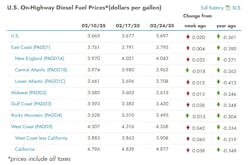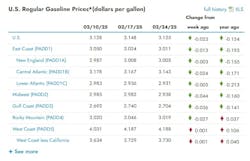While gasoline pump prices saw some reprieve across most of the U.S. this week, diesel prices continue to creep upward. The national average diesel pump price rose to $3.697, a 2-cent increase from last week, according to the government's weekly price tracking released February 24.
All but one region of the U.S. saw diesel price increases this week, according to the U.S. Energy Information Administration. The most significant increase was seen on the West Coast, with diesel prices now at $4.358. This is a 4-cent increase compared to last week. Surprisingly, this increase wasn’t entirely California-centered; without including California, the West Coast increase would’ve been 4.5 cents to $3.908. California itself only experienced an increase of 3.8 cents to $4.877.
The rest of the U.S. experienced smaller diesel price increases. The next biggest increase was the Gulf Coast by 3.8 cents to $3.420. The Midwest experienced a rise of 1.3 cents to $3.615. And the East Coast only saw a minimal increase of 0.4 cents to $3.795.
The only part of the U.S. to see a decrease in diesel prices this week was the Rocky Mountain area. The Rockies had a decrease of 1.5 cents to $3.495, the second smallest average diesel price in the U.S. currently.
However, according to AAA Motor Club, the current national diesel average is $3.673, 1 cent less than AAA’s diesel average from last week. This average is also 2.4 cents lower than EIA’s average for this week. And to look on the bright side, this is much lower than the average from a year ago of $4.085 by 41 cents.
See also: Diesel, gas prices on the rise in 2025
Gas prices fall across the U.S.
On the other hand, gasoline prices fell across the U.S. this week. The current national gasoline price average is $3.125, which is 2.3 cents lower than last week’s average, according to EIA. This average is 1.2 cents lower than the average from a year ago.
The Midwest saw the biggest fall in gas prices this week, going down to $2.938. This is 4.4 cents lower than last week’s average. The Gulf Coast average decreased to $2.704, a fall of 3.6 cents. The Rocky Mountain area had a decrease of 2.7 cents to $3.019. Coming in with the slightest decrease is the East Coast, with 1.3 cents to $3.011.
Unsurprisingly, the West Coast was the only part of the U.S. to see a rise in gas prices this week. The West Coast average is $4.188, rising by a mere 0.1 cents this week.
According to AAA, the national average for gasoline prices dropped this week to $3.144. Compared to last week’s average of $3.161, this is a 1.7-cent decrease. This is down further from last year’s average of $3.264.
About the Author

Jenna Hume
Digital Editor
Digital Editor Jenna Hume joined FleetOwner in November of 2023 and previously worked as a writer in the gaming industry. She has a bachelor of fine arts degree in creative writing from Truman State University and a master of fine arts degree in writing from Lindenwood University. She is currently based in Missouri.


